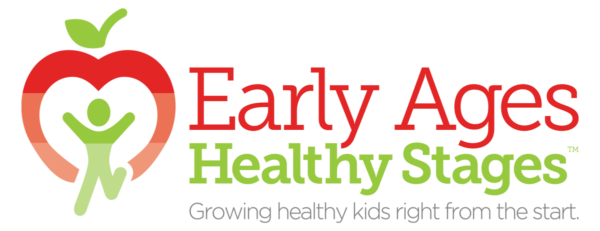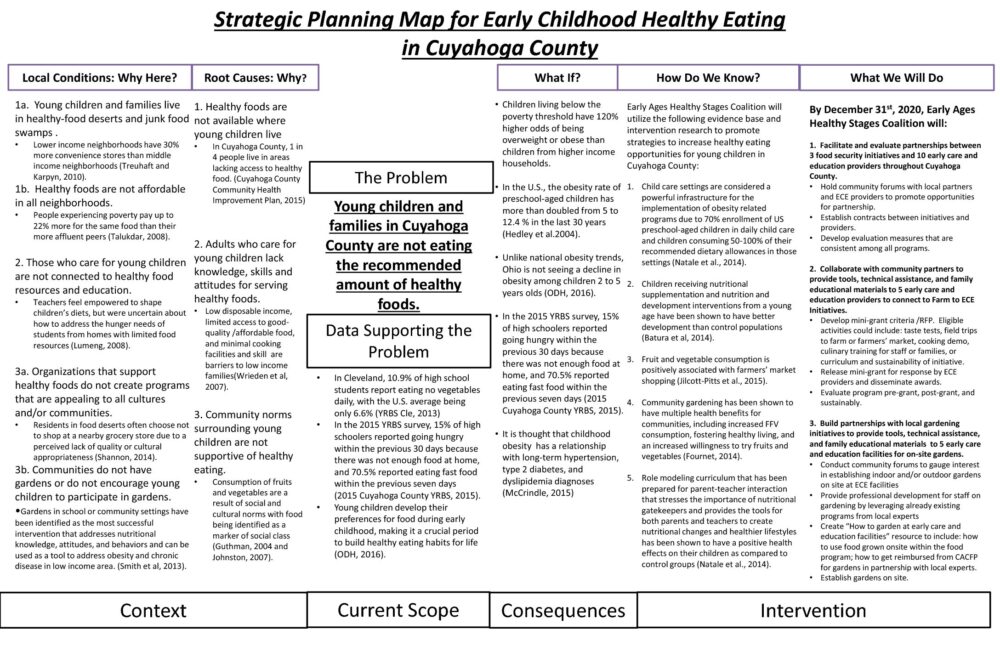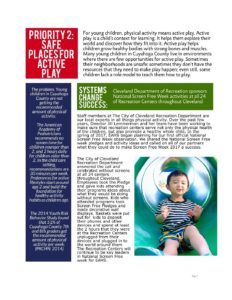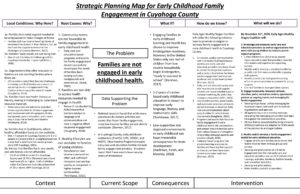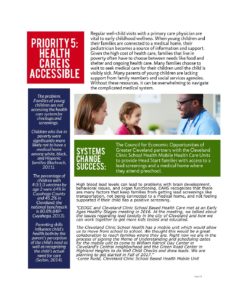Healthcare Access
Regular well-child visits with a primary care physician are vital to early childhood wellness. When young children and their families are connected to a medical home, their pediatrician becomes a source of support and information. Given the high cost of healthcare, families that live in poverty often have to choose between needs like food and shelter and ongoing healthcare. Many families choose to wait to seek medical care for their children until the child is visibly sick. Many parents of young children are lacking support from family members and social services agencies. Without these resources, it can be overwhelming to navigate the complicated medical system.

Healthcare Access | Our Goal:
Early Ages Healthy Stages will facilitate partnerships between Cuyahoga County’s world class healthcare, ECE providers and the families of young children by focusing on wellness, access, and collaboration.
Healthcare Access | Strategies for Change: EAHS is working to implement the following strategies to change the landscape of healthcare access for all young children.
The problem. Families of young children are not accessing the healthcare system for checkups and screenings. Children who live in poverty were significantly more likely not to have a medical home among white, black, and Hispanic families (Bachrach, 2011). The percentage of children with 4:3:1:3 vaccines by age 2 were 64% in Cuyahoga County and 45.2% in Cleveland; the national benchmark is 80.8% (HIP-Cuyahoga, 2013).
Parenting skills influence child’s health both by the parent’s perception of the child’s need as well as recognizing the child’s actual need for care (Serbin, 2014).
- Our Objectives: What we will do.
- Our Actions: How we will do it.
- Our Outcomes: How we will measure success.
Healthcare Access | Objective 1. By December 31st, 2020, Early Ages Healthy Stages Coalition will support the development of patient navigator and care coordinator programs to assist patients in person and via telephone to support their health management.
- Research which clinics have navigators, if the navigators interact with families of young children, and for what the navigators are responsible.
- Learn about best practices for navigators, as well as needs and opportunities for engaging with families in our communities.
- Recruit clinics to participate in establishing the navigator role and practices that are currently utilizing the role to share their successes.
- Evaluate through student Capstone.
- Measuring the number of new patient navigators
- Measuring the number of new care coordinator programs
- Our Objectives: What we will do.
- Our Actions: How we will do it.
- Our Outcomes: How we will measure success.
- Engage with medical schools, residency programs, and pediatric and family medicine practitioners to learn about needs and interests and how partnership with EAHS may be mutually beneficial starting January 2018.
- Develop a plan in partnership with medical schools, residency programs and health care providers to improve patient interaction.
- Revisit Strategic Planning goals for engaging medical schools (develop tools, presentations, recruitment, etc.) in summer 2018 and implement new goals in Fall 2018.
- Measuring the number of partnerships with medical schools
- Measuring the number of partnerships with residency programs
- Measuring the number of partnerships with PCPs or pediatricians
- Our Objectives: What we will do.
- Our Actions: How we will do it.
- Our Outcomes: How we will measure success.
- Assess families of interested centers to learn more about their medical needs.
- Establish relationship between EAHS partners and mobile units to develop a plan for collaboration.
- Explore current partnership between mobile units and CEOGC Head Start centers.
- Engage other EAHS partners to see if there are more opportunities for coordination of services between mobile units and ECE providers.
- Measuring the number of partnerships with mobile units and EAHS
- Measuring the number of ECE centers visited by mobile units
- Measuring the number of immunizations by mobile units at ECE centers
- Measuring the number of lab draws at ECE centers by mobile clinics (measuring lead and hct/HgB levels)
Healthy Activity | Systems Change Success Story:
The Council for Economic Opportunities of Greater Cleveland partners with the Cleveland Clinic School Health Mobile Health Care Units to provide Head Start families with access to a lead screenings and a medical home where they attend preschool.
 High blood lead levels can lead to problems with brain development, behavioral issues, and organ functioning. EAHS recognizes that there are many factors that keep families from getting lead screenings like transportation, not being connected to a medical home, and not feeling supported if their child has a positive screening.
High blood lead levels can lead to problems with brain development, behavioral issues, and organ functioning. EAHS recognizes that there are many factors that keep families from getting lead screenings like transportation, not being connected to a medical home, and not feeling supported if their child has a positive screening.
“CEOGC and Cleveland Clinic School Based Health Care met at an Early Ages Healthy Stages meeting in 2016. At the meeting, we talked about the issues regarding lead toxicity in the city of Cleveland and how we can work together to get more kids tested and educated. The Cleveland Clinic School Health has a mobile unit which would allow us to move from school to school. We thought this would be a great collaboration to reach families where they are. Right now we are in the process of signing the Memo of Understanding and scheduling dates for the mobile unit to come to William Patrick Day Center in Cleveland’s Central neighborhood and the Green Road Center in Highland Heights to do Well Child Checks and draw leads. We are planning to get started in Fall of 2017.” -Loree Rudd, Cleveland Clinic School Based Health Mobile Unit
Healthcare Access Working Group:
Co-Facilitators: Marquita Rockamore, Corporate College East and Roopa Thakur, Cleveland Clinic Foundation
Healthcare Access Strategic Planning Handouts:
Healthcare Access Strategic Planning Handouts:
Healthcare Access Working Groups Google Docs
Bachrach, A. I. (2011, October). Pediatric Medical Homes: Laying the Foundation of a Promising Method of Care. Retrieved April 11, 2017, from National Center for Children in Poverty: http://www.nccp.org/publications/pdf/text_1041.pdf
Center, N. C. (2008). Your Child’s Medical Home: Every Child Deserves a Medical Home Train the Trainer Program. Retrieved April 11, 2017, from North Carolina Public Health: http://www.spannj.org/Family2Family/medical_home/NC_Medical_Home_Train_the_Trainer.pdf
Cunningham, C. O., Sohler, N. L., Cooperman, N. A., Berg, K. M., Litwin, A. H., & Arnsten, J. H. (2011). Strategies to Improve Access to and Utilization of Health Care Services and Adherence to Antiretroviral Therapy Among HIV-Infected Drug Users. Substance Use & Misuse, 46(2-3), 218–232. http://doi.org/10.3109/10826084.2011.522840
Halfon, N. I. (2005, May). Quality of Preventive Health Care for Young Children: Strategies for Improvement. Retrieved April 11, 2017, from The Commonweath Fund: http://www.commonwealthfund.org/~/media/files/publications/fund-report/2005/may/quality-of-preventive-health-care-for-young-children–strategies-for-improvement/822_halfon_quality_preventive_hlt_care_young_child-pdf.pdf
HIP-Cuyahoga, H. I. (2013, March 21). Community Health Status Assessment for Cuyahoga County, Ohio. Retrieved March 10, 2017, from Health Improvement Partnership Cuyahoga County: http://www.naccho.org/uploads/downloadable-resources/Full-CHACHIPCombined-3-20-13.pdf
Isringhausen, K. T. & VanderWielen, L. M. & Vanderbilt, A. A. (2014). Addressing Health Care Disparities and Access to Dental Care while Improving Education: Schools of Dentistry and Federally Qualified Health Centers. Journal of Health Care for the Poor and Underserved 25(2), 670-674. The Johns Hopkins University Press. Retrieved June 20, 2017, from Project MUSE database
Karpman, M. G. (2016, April). Uninsurance among Young Childrem, 1997-2015. Retrieved April 11, 2017, from Urban Institute Health Policy Center: http://www.urban.org/sites/default/files/publication/79696/2000741-Uninsurance%20among%20Young%20Children-1997%E2%80%932015-Long-Term-Trends-and-Recent-Patterns.pdf
Mold, F.; de Lusignan, S. Patients’ Online Access to Their Primary Care Electronic Health Records and Linked Online Services: Implications for Research and Practice. J. Pers. Med. 2015, 5, 452-469.
Seid M., S. G. (2003). Parents’ Perceptions of Pediatric Primary Care Quality: Effects of Race/Ethnicity, Language, and Access. Health Services Research, 1009-1032.
Serbin, L. H. (2014). The Influence of Parenting on Early Childhood Health and Health Care Utilization. Journal of Peditric Psychology, 1161-1174.
Willenbring ML. Integrating care for patients with infectious, psychiatric, and substance use disorders: Concepts and approaches. AIDS. 2005;19(Suppl 3):S227–S237.
